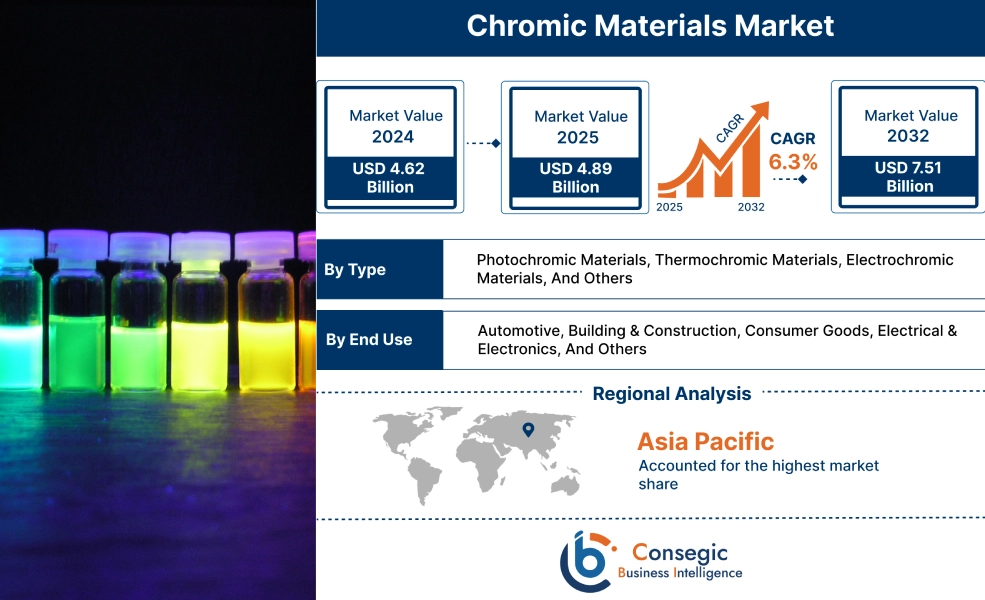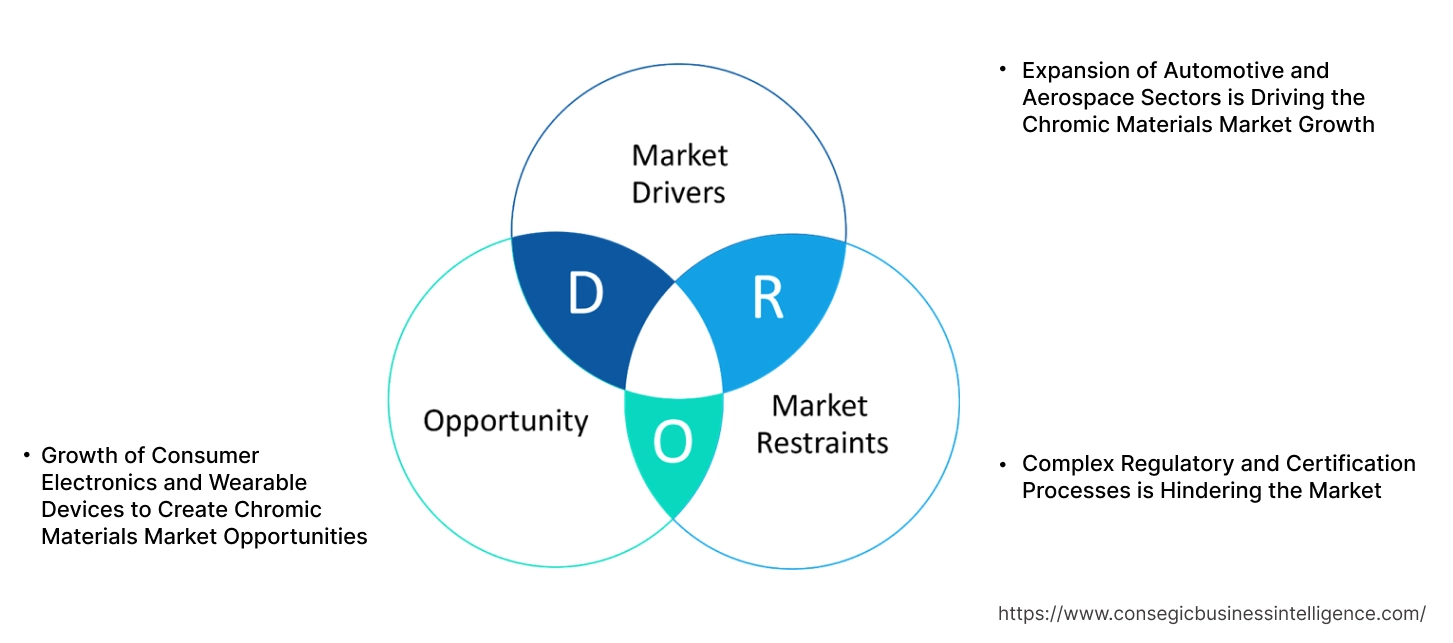Chromic Materials Market Size:
The Chromic Materials Market size is growing with a CAGR of 6.3% during the forecast period (2025-2032), and the market is projected to be valued at USD 7.51 Billion by 2032 from USD 4.62 Billion in 2024. Additionally, the market value for 2025 is attributed to USD 4.89 Billion.
Chromic Materials Market Scope & Overview:
Chromic materials are substances that have the ability to reversibly change their color or transparency when exposed to an external stimulus. This ability makes them incredibly valuable for a wide range of smart applications. The specific type of chromism indicates what triggers the change. For instance, photochromic materials react to light, thermochromic to temperature, and electrochromic to an electric current. These materials work by undergoing a temporary molecular alteration that shifts how they absorb and reflect light, resulting in a visible change. Key features of the materials are their controllability, reversibility, and versatility. These features in turn makes them essential for innovations in energy efficiency, security, advanced displays, among others.
Chromic Materials Market Dynamics - (DRO) :
Key Drivers:
Expansion of Automotive and Aerospace Sectors is Driving the Chromic Materials Market Growth.
In the automotive sector, thermochromic and electrochromic applications such as auto-dimming mirrors and smart window are becoming more prevalent, improving safety by reducing glare. Similarly, the aerospace sector utilizes chromic materials for smart windows that offer adjustable dimming, thereby enhancing the passenger comfort. Both sectors focus on advanced features, enhanced user experience and fuel economy drives the demand for chromic materials.
- For instance, according to Aerospace Industries Association, the aerospace and defense sector expected a rise of 7.1% from 2022 to 2023 in the U.S.
Hence, due to the aforementioned factors, growing automotive and aerospace sectors are driving the chromic materials market growth.
Key Restraints:
Complex Regulatory and Certification Processes is Hindering the Market.
Chromic materials have complex chemical compositions that require compliance with a variety of regulations regarding safety, health, and environmental regulations that vary by region. In addition to this, specific sectors such as automotive, aerospace, medical, and construction have their own rigorous performance and durability standards. Meeting these often involves expensive testing, and lengthy certification procedures, and extending time-to-market for new products. The changing landscape of these regulations further contributes towards hinderance in the market revenue due to the companies requiring compelling these regulations and constantly reformulate products and re-evaluate supply chains, slowing down innovation. Therefore, the above-mentioned factors are contributing to hindrances in the chromic materials market expansion.
Future Opportunities :
Growth of Consumer Electronics and Wearable Devices to Create Chromic Materials Market Opportunities.
Consumers are increasingly seeking more personalized and functional gadgets; wherein chromic materials are a suitable option to enhance user experience and differentiate products. They enable adaptive displays in smartphones and tablets for improved readability and energy efficiency. For wearables, this creates new opportunities for smartwatches with color-changing bezels or fitness trackers that visually indicate temperature shifts. The push for more customizable aesthetics and advanced functionality in portable and wearable tech is contributing to the increase in demand for these chromic compounds.
- For instance, according to IDC, the number of wearable sales reached more than 500 million units in 2024, representing a 5.4% increase from 2023.
Thus, as per analysis, surge of consumer electronics and wearable devices is expected to create chromic materials market opportunities.
Chromic Materials Market Segmental Analysis :
By Type:
Based on type, the market is categorized into photochromic materials, thermochromic materials, electrochromic materials, and others.
Trends in Type:
- The trend towards continuous improvements in response rates, durability, and cost-effectiveness are contributing to the commercial viability of electrochromic materials.
- There's a growing trend of preference in customization and personalization of consumer products using thermochromic materials.
The thermochromic materials segment accounted for the largest chromic materials market share in 2024.
- Thermochromic materials hold prominence due to their widespread and established use in smart packaging for temperature indication.
- Additionally, their popularity in consumer goods such as color-changing mugs and novelty items along with their growing adoption in textiles and apparel for responsive clothing are further contributing to the segmental revenue.
- In high-value applications such as smart windows, thermochromic materials are widely popular.
- Thus, as per the chromic materials market analysis, the thermochromic materials segment is dominating the chromic materials market demand.
The electrochromic materials segment is expected to grow at the fastest CAGR over the forecast period.
- Electrochromic materials are widely utilized in smart windows for both buildings and automobiles. They offer dynamic control over light and heat penetration. This ability to adjust transparency translates to significant energy savings.
- Additionally, their demand is increasing in auto-dimming mirrors in order to enhance driver safety and comfort.
- Moreover, continuous advancements in material performance, durability, and manufacturing processes, along with supportive green building regulations are further contributing to segmental revenue.
- For instance, the need for green materials is expected to increase by more than 4 times by 2030.
- Thus, based on the chromic materials market analysis, electrochromic materials is the fastest growing segment in the market trend.
By End Use:
Based on the end use, the market is categorized into automotive, building & construction, consumer goods, electrical & electronics, and others.
Trends in the End Use
- Increasing necessity for enhanced driver and passenger comfort, safety features and energy efficiency, driving automotive end use is a key trend.
The building & construction segment accounted for the largest market share of 33.59% in 2024.
- Building & construction hold prominence due to the increase in adoption of smart windows, particularly those utilizing electrochromic technology.
- These advanced windows are important for dynamically managing light and heat, leading to substantial energy savings in both commercial and residential buildings, thereby reducing reliance on HVAC systems.
- Furthermore, they significantly enhance the comfort of the occupants by cutting glare and offering instant privacy.
- Additionally, the global push for green building initiatives and smart cities development trend are further contributing to the segment's leading position.
- Thus, based on the market analysis, the building & construction segment is dominating chromic materials market demand.
The electrical & electronics segment is expected to grow at the fastest CAGR over the forecast period.
- Electrical & electronics is driven by the consistent requirement for advanced, interactive, and energy-efficient display technologies. Chromic materials are becoming important for next-generation flexible and transparent displays in devices such as smartphones and e-readers.
- They are also increasingly incorporated into wearable devices for adaptive visuals and dynamic aesthetics.
- Moreover, they are crucial for the development of augmented reality and virtual reality devices that require dynamic optical properties.
- For instance, according to Deloitte, the sale of consumer health and wellness wearable device to cross more than 400 million units in 2025 and is expected to growth at a CAGR of more than 10% over the forecast period.
- Thus, based on market analysis, electrical & electronics is the fastest-growing segment in the market trend.
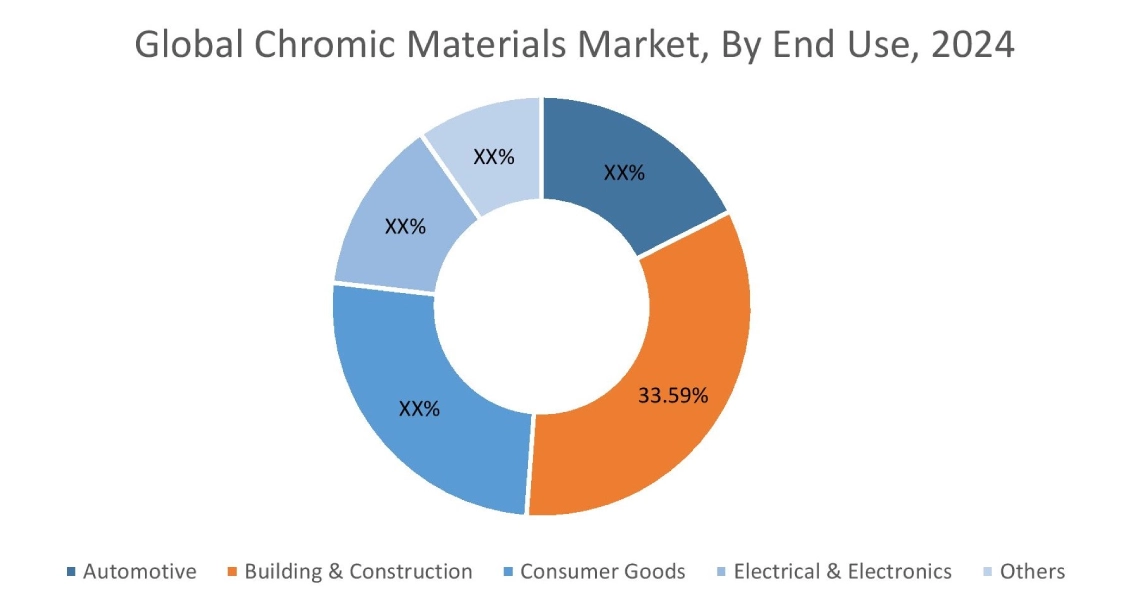
Regional Analysis:
The regional segment includes North America, Europe, Asia Pacific, the Middle East and Africa, and Latin America.
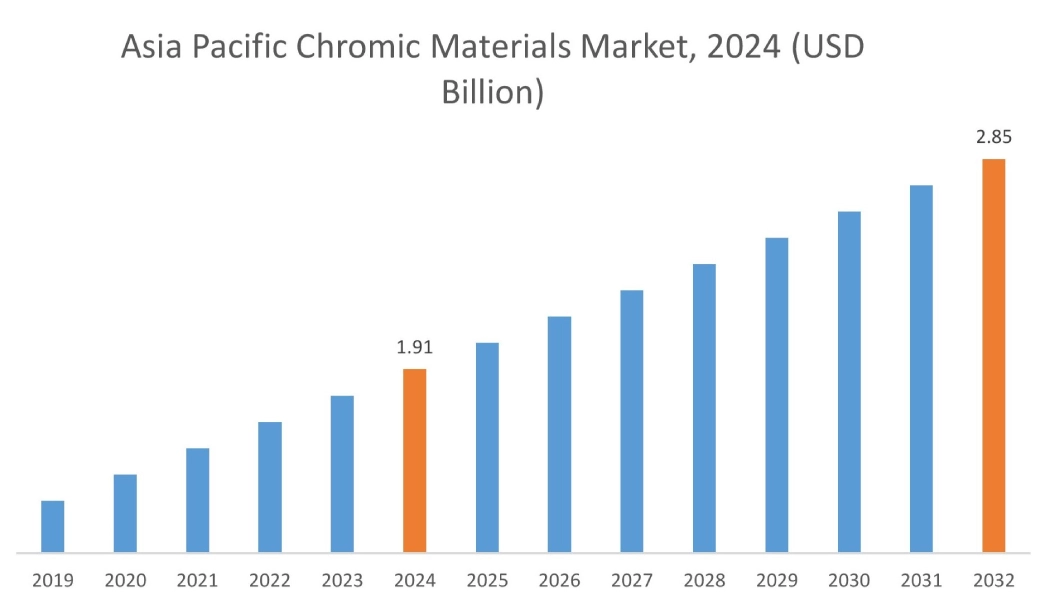
In 2024, Asia Pacific accounted for the highest market chromic materials market share at 41.31% and was valued at USD 1.91 Billion and is expected to reach USD 2.85 Billion in 2032. In Asia Pacific, China accounted for a market share of 38.23% during the base year of 2024. The rise of the automotive and aerospace sectors in the Asia Pacific region is a primary driver for the chromic materials market's growth. The regions dominance is driven by rising incomes in APAC's automotive sector, particularly in countries such as China, Japan, and South Korea, which are increasingly adopting electrochromic smart windows and auto-dimming mirrors to boost comfort, safety, and fuel efficiency in a high volume of vehicle production.
For instance,
- According to Just Auto, Light Vehicle (LV) production experienced a growth rate of 10% in 2023 across Asia Pacific.
Overall, as per analysis, aforementioned factors are driving the market in the Asia Pacific.
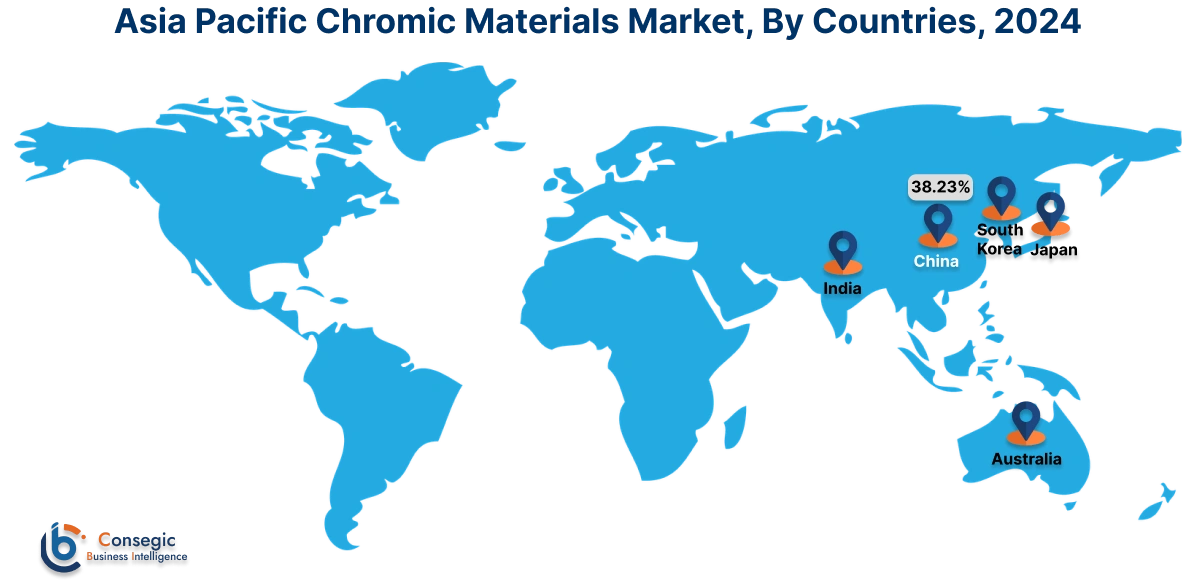
In Europe, the chromic materials industry is experiencing the fastest growth with a CAGR of 8.4% over the forecast period. Europe's biomedical and healthcare sectors is a growing market for chromic materials, driven by the region’s advanced medical technology focus and an aging population. These materials are increasingly used in smart diagnostics and sensors, enabling applications like thermochromic temperature indicators for sensitive pharmaceuticals and halochromic pH sensors in wound dressings to detect infection. However, this market faces challenges from stringent regulations like the EU Medical Device Regulation (MDR), that require rigorous testing for biocompatibility and safety.
The growing North American consumer electronics and wearable devices market is a key driver for chromic materials. The market is driven by tech-savvy consumer base. Chromic materials enable adaptive displays in smartphones and tablets, improving readability and energy efficiency, and provide aesthetic and functional components for wearables such as smartwatches and smart glasses. This strong regional preference for advanced, interactive, and visually engaging technology is significantly contributing to the region’s demand.
Advancements in printing technologies are a significant driver for the chromic materials market expansion in Latin America. These technologies are increasing accessibility for various products due to their efficient and cost-effective application of chromic inks onto diverse surfaces. This is contributing to the region's growing smart packaging market, where printed thermochromic indicators ensure food safety and anti-counterfeiting measures. Furthermore, the growth of the middle class is boosting need for innovative consumer goods including color-changing apparel and toys.
The chromic materials market in the Middle East and Africa is significantly driven by infrastructure development across the region. This is driven by initiatives of mega-projects and smart city initiatives in Gulf Cooperation Council (GCC) nations, such as NEOM and Masdar City, which heavily incorporate smart electrochromic windows for energy efficiency in hot climates. Furthermore, the increase in tourism and hospitality sector in the Middle East and growing energy efficiency mandates across the MEA region are creating strong demand for these adaptive materials.
Top Key Players and Market Share Insights:
The Global Chromic Materials Market is highly competitive with major players providing products to the national and international markets. Key players are adopting several strategies in research and development (R&D) and product innovation to hold a strong position in the global Chromic Materials market. Key players in the Chromic Materials industry include
- Merck KGaA (Germany)
- Matsui International Company (Japan)
- QCR Solutions Corp (US)
- Chromatic Technologies Inc (US)
- Olikrom Industry (France)
- Milliken & Company (US)
- Tokuyama Corporation (Japan)
- Flint Group (UK)
- Nova by Saint-Gobain (US)
- SpotSee (US)
Chromic Materials Market Report Insights :
| Report Attributes | Report Details |
| Study Timeline | 2019-2032 |
| Market Size in 2032 | USD 7.51 Billion |
| CAGR (2025-2032) | 6.3% |
| By Type |
|
| By End Use |
|
| By Region |
|
| Key Players |
|
| North America | U.S. Canada Mexico |
| Europe | U.K. Germany France Spain Italy Russia Benelux Rest of Europe |
| APAC | China South Korea Japan India Australia ASEAN Rest of Asia-Pacific |
| Middle East and Africa | GCC Turkey South Africa Rest of MEA |
| LATAM | Brazil Argentina Chile Rest of LATAM |
| Report Coverage |
|
Key Questions Answered in the Report
How big is the Chromic Materials market? +
In 2024, the Chromic Materials market is USD 4.62 Billion.
Which is the fastest-growing region in the Chromic Materials market? +
Europe is the fastest-growing region in the Chromic Materials market.
What specific segmentation details are covered in the Chromic Materials market? +
By Type and End Use segmentation details are covered in the Chromic Materials market.
Who are the major players in the Chromic Materials market? +
Merck KGaA (Germany), Milliken & Company (US), Tokuyama Corporation (Japan), Flint Group (UK) are some of the major players in the market.
